Classification and Assessment Methods for Mountain Channel Habitats in the Chishui River Basin, China
Abstract
1. Introduction
2. Materials and Methods
2.1. Study Region and Technical Procedures
2.2. Habitat Classification
2.2.1. Extraction of Basic Data
2.2.2. Parameters Used for the Habitat Classification
2.2.3. River Habitat Classification
2.3. Habitat Evaluation
2.3.1. Metrics Used for the Habitat Assessment Criteria
2.3.2. Habitat Sampling
2.3.3. Determination of Comprehensive Habitat Quality Index (CHQI)
3. Results
3.1. Spatial Habitat Types
3.2. CHQI and Habitat Health
3.3. Traits of the Metrics and Habitat Characteristics
4. Discussion
4.1. Performance of Our Habitat Assessment System
4.2. Habitat Status of the Chishui River Basin
5. Conclusions
Author Contributions
Funding
Institutional Review Board Statement
Informed Consent Statement
Data Availability Statement
Acknowledgments
Conflicts of Interest
References
- Surell, A. Étude sur les Torrents des Hautes-Alpes; Carilian-Goeury: Paris, France, 1841. [Google Scholar]
- Dana, J.D. On denudation in the Pacific. Am. J. Sci. 1850, 2, 48–62. [Google Scholar]
- Shaler, N.S. The Origin and Nature of Soils; U.S. Geological Survey 12th Annual Report. 1891; pp. 213–345. Available online: https://xueshu.baidu.com/usercenter/paper/show?paperid=893ebca413bf00a03b4c0fa65ca4a84e&site=xueshu_se&hitarticle=1 (accessed on 3 February 2022).
- Flotemersch, J.E.; North, S.; Blocksom, K.A. Evaluation of an alternate method for sampling benthic macroinvertebrates in low-gradient streams sampled as part of the National Rivers and Streams Assessment. Environ. Monit. Assess. 2014, 186, 949–959. [Google Scholar] [CrossRef] [PubMed][Green Version]
- Montgomery, D.R.; Buffington, J.M. Channel-reach morphology in mountain drainage basins. Geol. Soc. Am. Bull. 1997, 109, 596–611. [Google Scholar] [CrossRef]
- Rosgen, D.L. A Classification of Natural Rivers. Catena 1994, 22, 169–199. [Google Scholar] [CrossRef]
- Hughes, R.M.; Herlihy, A.T.; Kaufmann, P.R. An Evaluation of Qualitative Indexes of Physical Habitat Applied to Agricultural Streams in Ten U.S. States1. JAWRA J. Am. Water Resour. Assoc. 2010, 46, 792–806. [Google Scholar] [CrossRef]
- Belletti, B.; Rinaldi, M.; Bussettini, M.; Comiti, F.; Gurnell, A.; Mao, L.; Nardi, L.; Vezza, P. Characterising physical habitats and fluvial hydromorphology: A new system for the survey and classification of river geomorphic units. Geomorphology 2017, 283, 143–157. [Google Scholar] [CrossRef]
- Lee, B.; Leroy, P.N.; Daniel, M.; Thomas, D.; Gordon, R.; George, P.; Michael, P. The Network Dynamics Hypothesis: How Channel Networks Structure Riverine Habitats. BioScience 2004, 54, 413–427. [Google Scholar]
- Soranno, P.A.; Spence, C.K.; Webster, K.E.; Bremigan, M.T.; Wagner, T.; Stow, C.A. Using Landscape Limnology to Classify Freshwater Ecosystems for Multi-ecosystem Management and Conservation. BioScience 2010, 60, 440–454. [Google Scholar] [CrossRef]
- Brinkhurst, R.O. The Benthos of Lakes; St. Martin’s Press: New York, NY, USA, 1974. [Google Scholar]
- Shuter, B.J.; Jones, M.L.; Korver, R.M.; Lester, N.P. A general, life history based model for regional management of fish stocks: The inland lake trout fisheries (Salvelinus namaycush) of Ontario. Can. J. Fish. Aquat. Sci. 1998, 55, 2161–2177. [Google Scholar] [CrossRef]
- Euliss, N.H.; LaBaugh, J.W.; Fredrickson, L.H.; Mushet, D.M.; Laubhan, M.K.; Swanson, G.A.; Winter, T.C.; Rosenberry, D.O.; Nelson, R.D. The wetland continuum: A conceptual framework for interpreting biological studies. Wetlands 2004, 24, 448–458. [Google Scholar] [CrossRef]
- Wolfgang, J.J.; Maria, T.; Fernandez, P.; Schoengart, J.; Wittmann, F. A classification of major natural habitats of Amazonian white-water river floodplains (va´rzeas). Wetl. Ecol. Manag. 2012, 20, 461–475. [Google Scholar]
- Davenport, A.J.; Gurnella, A.M.; Armitage, P.D. Habitat survey and classification of urban rivers. River Res. Appl. River Res. Appl. 2004, 20, 687–704. [Google Scholar] [CrossRef]
- Dudgeon, D.; Arthington, A.H.; Gessner, M.O.; Kawabata, Z.; Knowler, D.J.; Leveque, C.; Naiman, R.J.; Prieur Richard, A.H.; Soto, D.; Stiassny, M.L. Freshwater biodiversity: Importance, threats, status and conservation challenges. Biol. Rev. 2010, 81, 163–182. [Google Scholar] [CrossRef]
- Corlett, R.T. Tropical rainforests and climate change. Ref. Modul. Earth Syst. Environ. Sci. 2016, 1–5. [Google Scholar]
- Ormerod, S.; Dobson, M.; Hildrew, A.; Townsend, C. Multiple stressors in freshwater ecosystems. Freshw. Biol. 2010, 55, 1–4. [Google Scholar] [CrossRef]
- Gomes-Silva, G.; Cyubahiro, E.; Wronski, T.; Riesch, R.; Apio, A.; Plath, M. Water pollution affects fish community structure and alters evolutionary trajectories of invasive guppies (Poecilia reticulata). Sci. Total Environ. 2020, 730, 138912. [Google Scholar] [CrossRef] [PubMed]
- Ngor, P.B.; McCann, K.S.; Grenouillet, G.; So, N.; McMeans, B.C.; Fraser, E.; Lek, S. Evidence of indiscriminate fishing effects in one of the world’s largest inland fisheries. Sci. Rep. 2018, 8, 1–12. [Google Scholar] [CrossRef] [PubMed]
- Ruaro, R.; Gubiani, É.A. A scientometric assessment of 30 years of the Index of Biotic Integrity in aquaticecosystems: Applications and main flaws. Ecol. Indic. 2013, 29, 105–110. [Google Scholar] [CrossRef]
- Bovee, K.D. A Guide to Stream Habitat Analysis Using the Instream Flow Incremental Methodology; Instream flow information paper No.12. FWS/OBS-82-26; US Fish and Wildlife Service Biological Services Program: Bailey’s Crossroads, VA, USA, 1982. [Google Scholar]
- Hill, J.; Grossman, G.D. An energetic model of microhabitat use for rainbow trout and rosyside dace. Ecology 1993, 74, 685–698. [Google Scholar] [CrossRef]
- Maddock, I. The importance of physical habitat assessment for evaluating river health. Freshw. Biol. 1999, 41, 373–391. [Google Scholar] [CrossRef]
- Vaughan, I.P. Habitat indices for rivers: Derivation and applications. Aquat. Conserv. 2010, 20, 4–12. [Google Scholar] [CrossRef]
- Barbour, M.T. Biological assessment strategies: Applications and limitations. In Whole Effluent Toxicity Testing: An Evaluation of Methods and Prediction of Receiving System Impacts; Grothe, D.R., Dickson, K.L., Reed, D.K., Eds.; SETAC Press: Pensacola, FL, USA, 1996; pp. 245–270. [Google Scholar]
- Davies, N.M.; Norris, R.H.; Thoms, M.C. Prediction and assessment of local stream habitat features using large-scale catchment characteristics. Freshw. Biol. 2000, 45, 343–369. [Google Scholar] [CrossRef]
- Oliveira, S.V.; Cortes, R.M.V. A biologically relevant habitat condition index for streams in northern Portugal. Aquat. Conserv. 2005, 15, 189–210. [Google Scholar] [CrossRef]
- He, Y.F.; Wang, J.W.; Lek, S.; Cao, W.X.; Lek-Ang, S. Structure of endemic fish assemblage in the upper Yangtze River Basin. River Res. Appl. 2011, 27, 59–75. [Google Scholar] [CrossRef]
- Lin, P.C.; Liu, F.; Li, M.Z.; Gao, X.; Liu, H.Z. Spatial pattern of fish assemblages along the river-reservoir gradient caused by the Three Gorge Reservoir (TGR). Acta Hydrobiol. Sin. 2018, 42, 1124–1134. [Google Scholar]
- Zhang, X.; Gao, X.; Wang, J.W.; Cao, X.W. Extinction risk and conservation priority analysis for 64 endemic fishes in the Upper Yangtze River, China. Environ. Biol. Fishes 2015, 98, 261–272. [Google Scholar] [CrossRef]
- Liu, F.; Wang, J.; Zhang, F.B.; Liu, H.Z.; Wang, J.W. Spatial organization of fish assemblages in the Chishui River, the last free-flowing tributary of the upper Yangtze River, China. Ecol. Freshw. Fish 2020, 30, 1–13. [Google Scholar]
- Wu, J.; Wang, J.; He, Y.; Cao, W. Fish assemblage structure in the Chishui River, a protected tributary of the Yangtze River. Knowl. Manag. Aquat. Ecosyst. 2011, 400, 170–181. [Google Scholar] [CrossRef]
- Jiang, X.M.; Xiong, J.; Xie, Z.C.; Chen, Y.F. Longitudinal patterns of macroinvertebrate functional feeding groups in a Chinese river system: A test for river continuum concept (RCC). Quat. Int. 2011, 244, 289–295. [Google Scholar] [CrossRef]
- Tang, G.A.; Yang, X. Experimental Tutorial on Spatial Analysis of Geographic Information System; Science Press: Beijing, China, 2012. [Google Scholar]
- Higgins, J.V.; Bryer, M.T.; Khoury, M.L.; Fitzhugh, T.W. A freshwater classification approach for biodiversity conservation planning. Conserv. Biol. 2005, 19, 432–445. [Google Scholar] [CrossRef]
- Kong, W.J.; Zhang, Y.; Wang, Y.H. River habitats classification in Taizi River based on spatial data. Res. Environ. Sci. 2013, 26, 487–493. [Google Scholar]
- Oksanen, J.; Blanchet, F.G.; Friendly, M.; Kindt, R.; Legendre, P.; McGlinn, D.; Solymos, P. Vegan: Community Ecology Package; R package version 2.5-7. 2020. Available online: https://xueshu.baidu.com/usercenter/paper/show?paperid=1h4c0en0bb6y0ar0052v0ae03k594560 (accessed on 3 February 2022).
- Clarke, K.R.; Warwick, R.M. Change in Marine Communities: An Approach to Statistical Analysis and Interpretation; Plymouth Marine Laboratory: Plymouth, UK, 1994; p. 144. [Google Scholar]
- Barbour, M.T.; Gerritsen, J.; Snyder, B.D.; Stribling, J.B. Rapid Bioassessment Protocols for Use in Stream and Wadeable Rivers: Periphyton, Benthic Macroinvertebrates and Fish, 2nd ed.; EPA 841-B-99-002; U.S. Environmental Protection Agency, Office of Water: Washington, DC, USA, 1999. [Google Scholar]
- Taft, B.; Koncelik, J.P. Methods for Assessing Habitat in Flowing Waters: Using the Qualitative Habitat Evaluation Index (QHEI); OHIO EPA Technical Bulletin EAS.; State of Ohio Environmental Protection Agency, Division of Surface Water: Washington, DC, USA, 2006. [Google Scholar]
- Zheng, B.H.; Zhang, Y.; Li, Y.B. Study of indicators and methods for river habitat assessment of Liao River Basin. Acta Sci. Circumstantiae 2007, 27, 928–936. [Google Scholar]
- Zhou, X.; Yang, R.H.; Yang, Z.; Zheng, Z.W.; Shi, F.; Chi, S.Y.; Zhu, A.M.; Shao, K.; Yuan, Y.J.; Wan, C.Y. Habitat health assessment of typical tributaries of the Yangtze River. J. Hydroecology 2021, 42, 11. [Google Scholar]
- Kwang, G.A.; Seok, S.P.; Shin, J.Y. An evaluation of a river health using the index of biological integrity along with relations to chemical and habitat conditions. Environ. Int. 2002, 28, 411–420. [Google Scholar]
- Wang, Z.S.; Jiang, L.G.; Huang, M.J.; Zhang, C.; Yu, X.B. Biodiversity status and its conservation strategy in the Chishui River basin. Recourse Environ. Yangtze Basin 2007, 16, 175–180. [Google Scholar]
- Zhang, X. Setting conservation priority to endemic fishes and their habitats during the hydropower development in the Lower Jinsha River. Master’s Thesis Dissertation, Chinese Academy of Sciences, Beijing, China, 2018. [Google Scholar]
- Wang, J.; Huang, Z.L.; Li, H.Y.; Jiang, X.M.; Li, Z.F.; Meng, X.L.; Xie, Z.C. Construction of Macroinvertebrate Integrity-Based Health Assessment Framework for the Chishui River. Environ. Monit. China 2018, 34, 69–79. [Google Scholar]
- Chen, K.; Jia, Y.; Xiong, X.; Sun, H.; Chen, Y. Integration of taxonomic distinctness indices into the assessment of headwater streams with a high altitude gradient and low species richness along the upper Han River, China. Ecol. Indic. 2020, 112, 106106. [Google Scholar] [CrossRef]
- Li, Z.; Zeng, B. Health assessment of important tributaries of Three Georges Reservoir based on the benthic index of biotic integrity. Sci. Rep. 2020, 10, 18743. [Google Scholar] [CrossRef]
- Liu, F.; Yang, G.H.; Liu, D.M.; Li, L.; Wang, X.; Zhang, Z.; Liu, H.Z. Current situation and conservation strategies of fish resources in the Xishui River. Freshw. Fish. 2019, 49, 36–43. [Google Scholar]
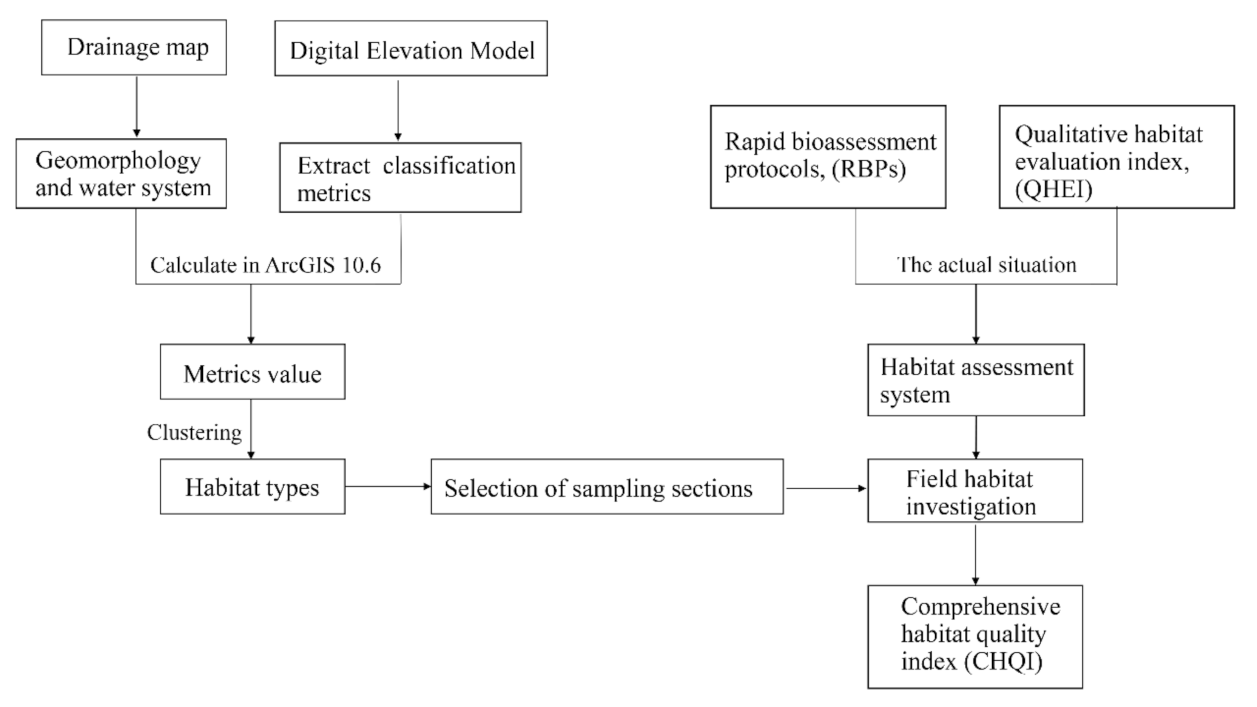
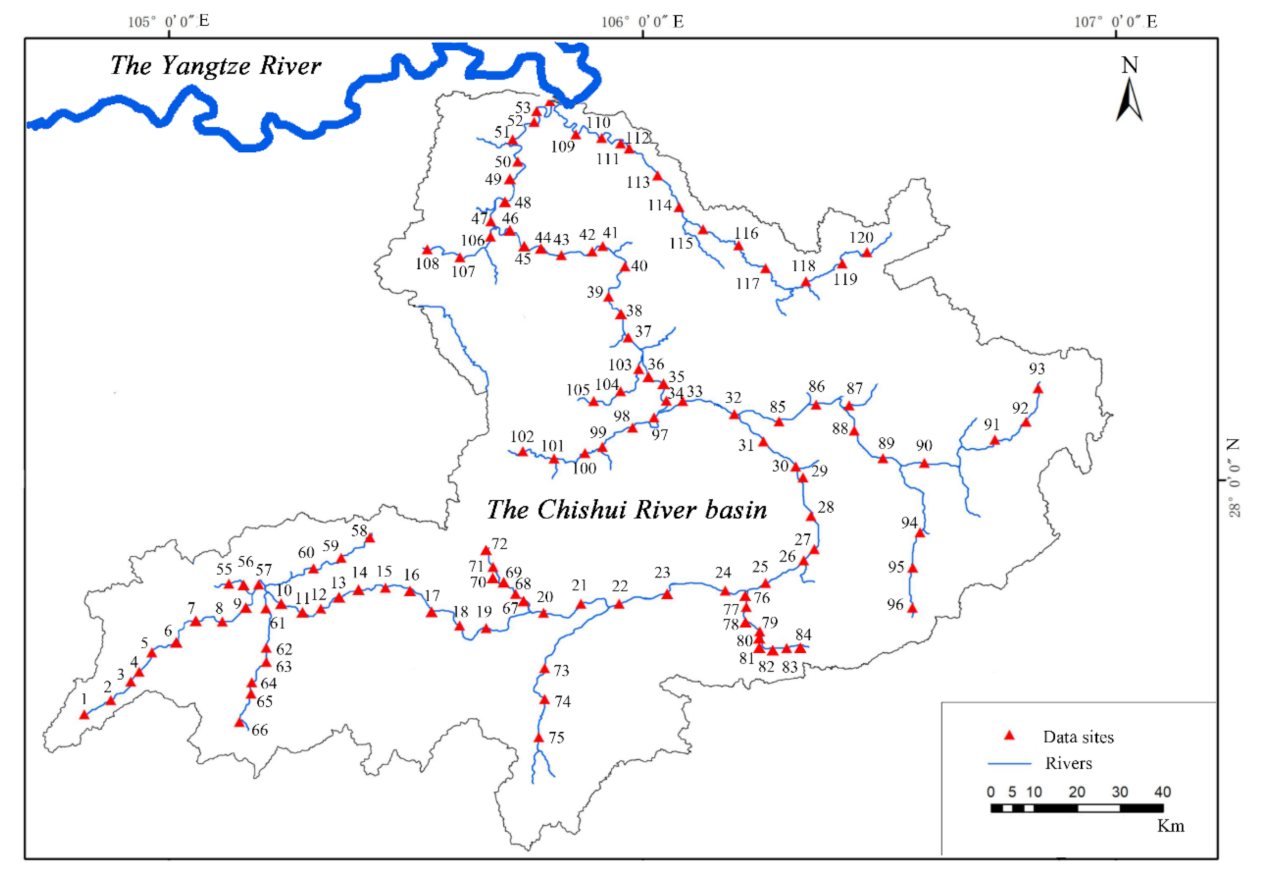
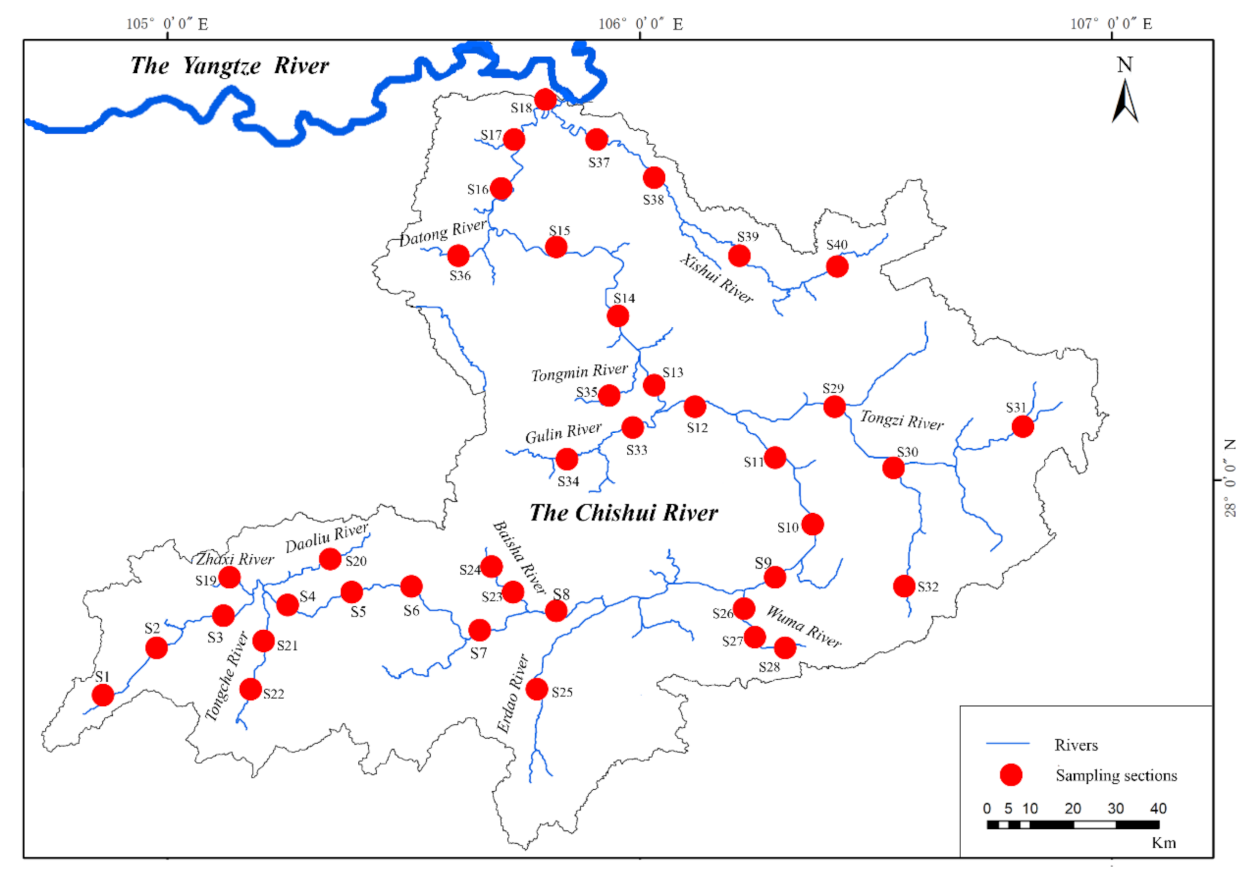
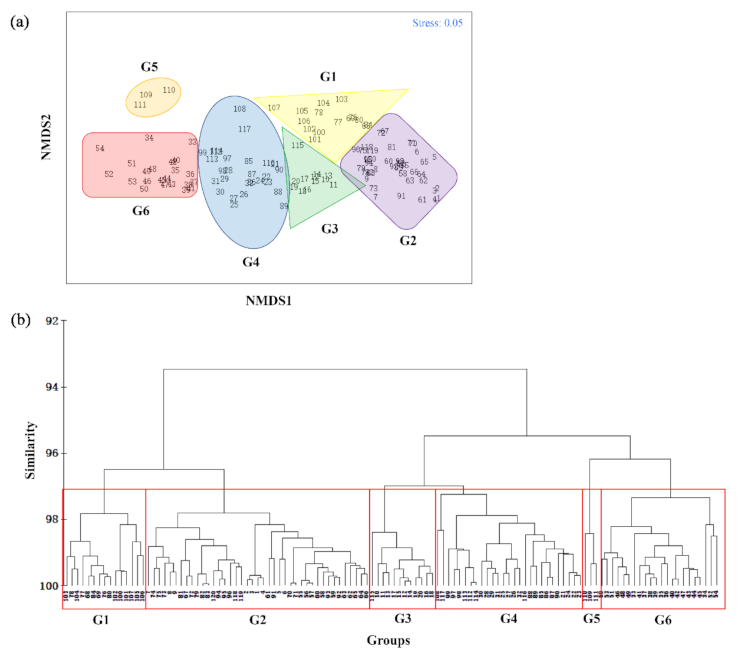
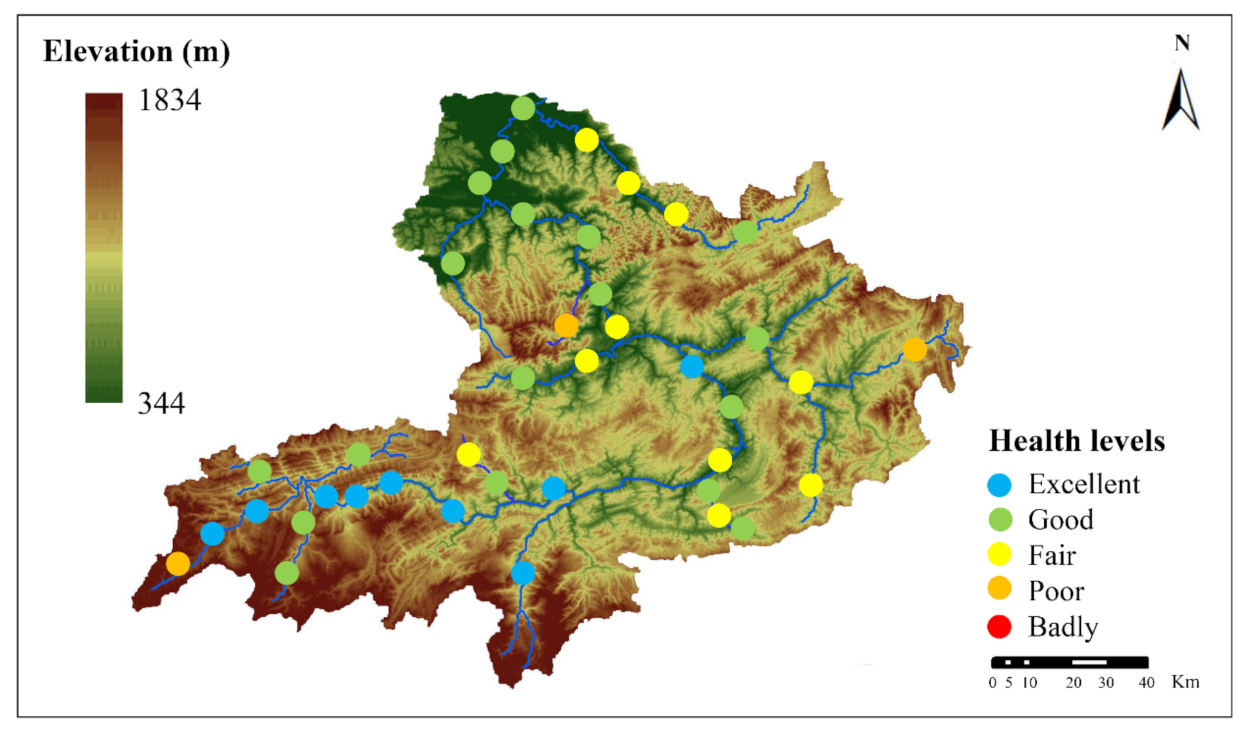
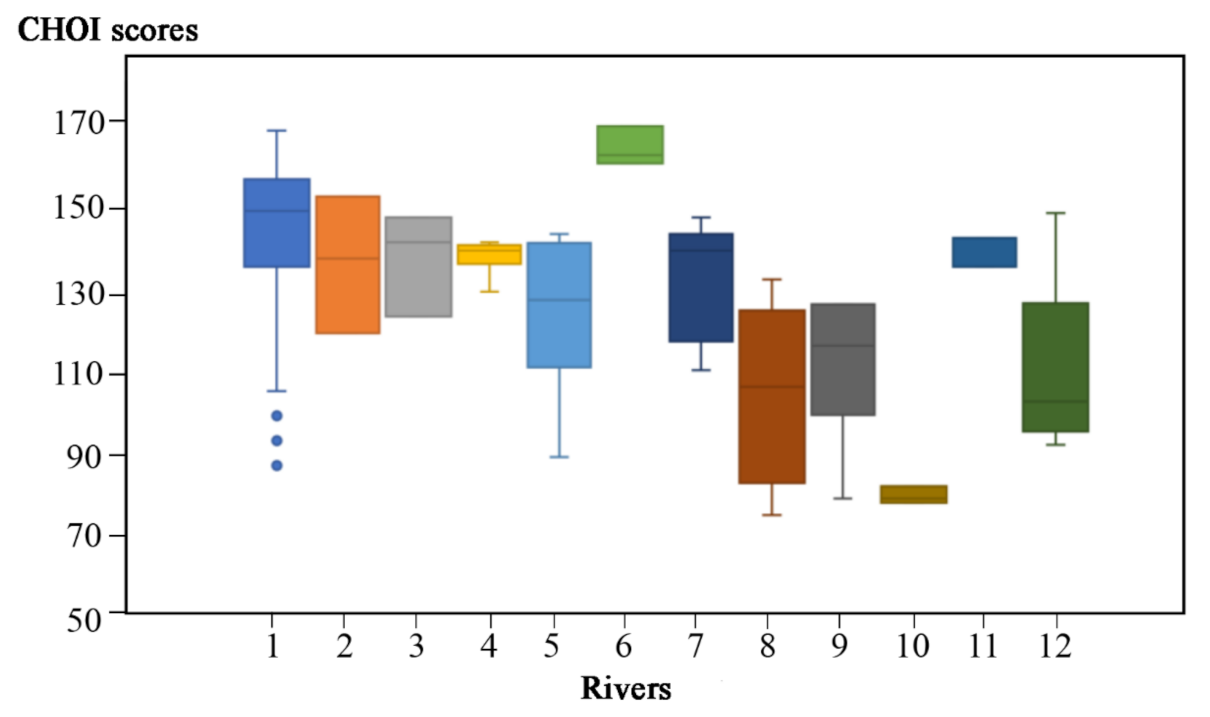
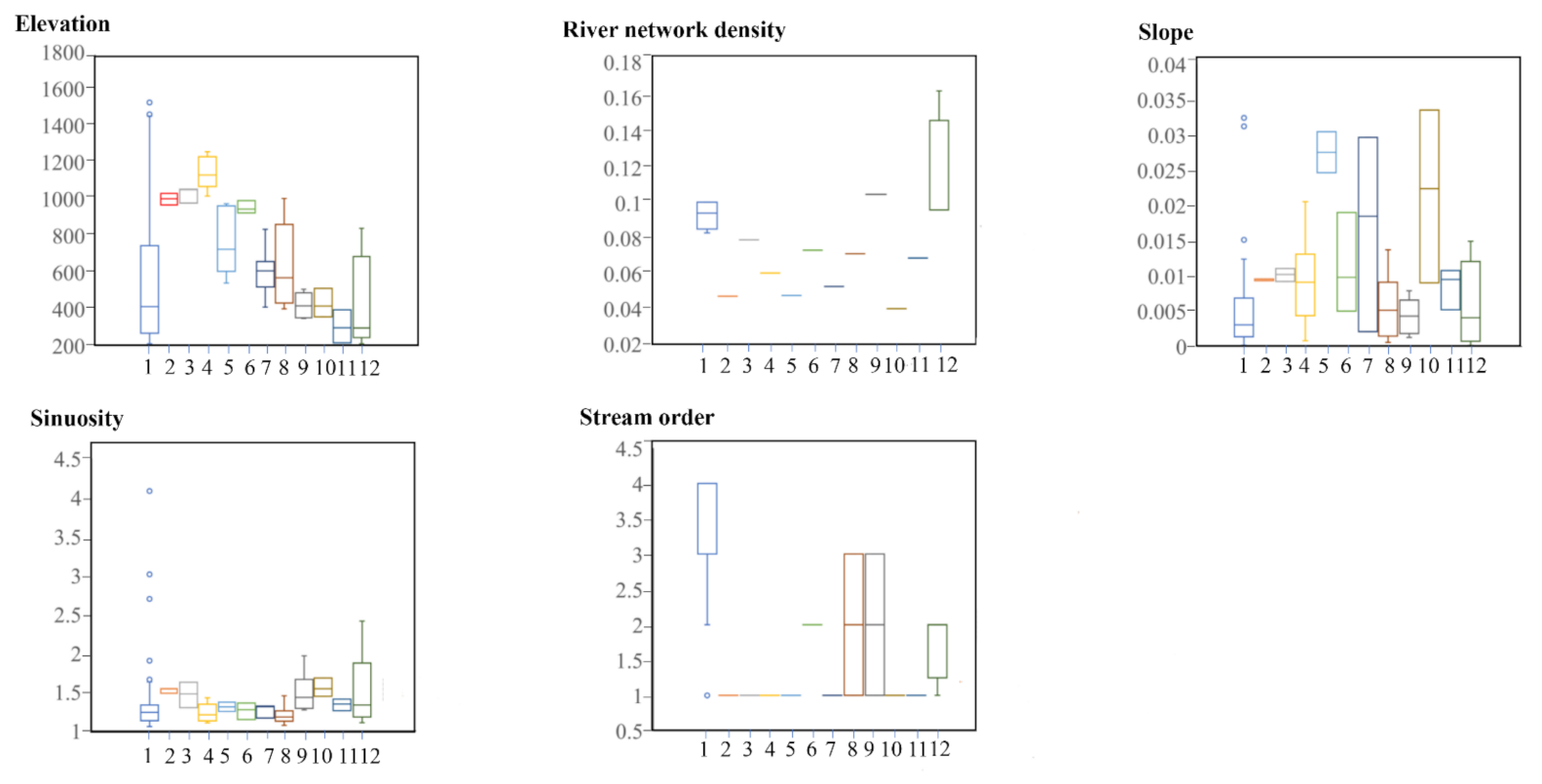

| Habitat Metrics | Environmental Grades | |||
|---|---|---|---|---|
| Excellent | Good | Fair | Poor | |
| 1 Water environmental status | ||||
| Pool form | Balanced combination of deep and shallow pools | Deep pools are more than 50% | Shallow pools are more than 50% | Pools are less than 20% or there is no pools |
| Transparency | Clear, transparency > 1 m or | Relatively clear, transparency is 0.5–1 m | Relatively turbid, transparency is 0.3–0.5 m | Very turbid, transparency < 0.3 m |
| Water smell | No odor | Has a slight peculiar smell | Has obvious smell | Pungent smell |
| Flow regime | All 4 flow regimes appear (slow-deep, slow-shallow, fast-deep, fast-shallow), slow is <0.3 m/s, and deep is >0.5 m | Only 3 flow regimes appear (lack of fast-shallow flow regimes have lower scores than others) | Only 2 flow regimes appear (lack of fast-shallow or slow-shallow have lower scores) | Dominated by 1 flow regime (deep-slow have lower score) |
| Water color | Water color is transparent, no precipitation after standing | Water color is basically transparent, and there are some precipitation after standing | The water is darker and more algae | Water color is black or eutrophication |
| 2 River morphology | ||||
| Riverbed type | Deep pools and shallow pools | Flat riverbed | Ladder flow or reservoir | Dry riverbed |
| Sedimentation characteristics | 70% of the sediment suitable for aquatic organisms to settle (root plants, or gravels with a diameter of 20–256 mm) | 40–70% of the sediment suitable for aquatic organisms to settle (newly fallen trees are not suitable for settlement and have lower score) | The stable habitat is 20–40%, and the heterogeneity of bottom is low (such as the bedrock > 4000 mm) | The stable habitat is only less than 20%, the availability of substrate is low, and it is often severely disturbed or lacked. |
| Silt coverage | Silt substrate is less than 10% | Silt substrate is about 10–40% | Silt substrate is about 40–60% | Silt substrate is more than 60% |
| Embeddedness | 0–25% fine-grained sediments (0.06–2.0 mm in diameter) are embedded around pebbles and boulders, and the sediments show spatial diversity | 25–50% fine-grained sediment are embedded around pebbles and boulders | 50–75% fine-grained sediment are embedded around pebbles and boulders | More than 75% of fine-grained sediments are embedded around pebbles and boulders |
| Sinuosity | Sinuosity is higher than 2.0, and the river course is extremely curved | Sinuosity is 1.5–2.0, and the river course is curved | Sinuosity is 1.2–1.5, the river course is slightly curved | Sinuosity is lower than 1.2, and the river course is straight |
| River harden and canalization | Without channelization and hardening, river remains in natural condition | Hardened river course is less than 40% | Hardened river course is 40–80% | Hardened river course is more than 80% |
| 3 Riparian zone | ||||
| Riparian stability | River bank is stable and the erosion area is less than 10% | River bank is relatively stable and the erosion area is 10–30% | River bank is unstable and the erosion area is less than 30–60% | River bank has collapsed and the erosion area is more than 60% |
| Riparian plant width | Riparian plant width is higher than 18 m | Riparian plant width is 12–18 m | Riparian plant width is 6–12 m | Riparian plant width is less than 6 m |
| Riparian plant coverage | 90% of the coastal zone with 50m of vegetation cover and various species | 70–90% of the coastal zone with 50m of vegetation cover and single species | 50–70% of the coastal zone with 50m of vegetation cover and partly exposed | Less than 50% of the coastal zone with 50m of vegetation cover and most exposed |
| Dominant vegetation | There are more than 50% arbor forest | There are more than 50% shrubbery | There are more than 50% grassland | There are more than 50% farmland |
| 4 Human disturbance | ||||
| Sewage outlet | There is no any sewage outlet | There is 1 sewage outlet in the river section, which is slightly polluted | There are 2 sewage outlets in the river section with obvious pollution | There are more than 3 sewage outlets in the river section |
| Solid waste point | Keep neat and no garbage | There are scattered garbage fragments | There is 1 solid waste point, but not yet extended into the river | There are more than 2 solid waste points and have spread to the river |
| dams and channel engineering | There is no dam or channel engineering, no shipping activities | There is 1 dam or channel engineering, and occasional shipping activities | There are 2 dams or channel engineering and shipping activities are more frequent | There are 3 dams or channel engineering and some shipping terminals |
| Cross-river bridge | There is no bridge across the river | There is 1 bridge across the river | There are 2 bridges across the river, and at least one bridge has occasional traffic | There are 3 bridges across the river, and at least one bridge has frequent traffic with loud noise |
| Residential area and industry | There are only less than 10% residential or industrial areas in the 50 m of coastal zone | There are 10–30% residential or industrial areas in the 50 m of coastal zone | There are 30–50% residential or industrial areas in the 50 m of coastal zone | There are more than 50% residential or industrial areas in the 50 m of coastal zone |
| Score | 10 9 | 8 7 6 | 5 4 3 | 2 1 0 |
| Habitat Types | Number of Data Sites | Proportion | Average Elevation (m) | Average Sinuosity (km/km) | Average Slope (km/km) | Average River Network Density (km/km2) | Average Stream Order |
|---|---|---|---|---|---|---|---|
| Steep tributaries habitat | 15 | 12.50% | 484.60 | 1.41 | 0.0186 | 0.062 | 1 |
| High-altitude headwater habitat | 41 | 34.17% | 996.49 | 1.28 | 0.0119 | 0.073 | 1.15 |
| Upstream dense river net habitat | 12 | 10.00% | 709.67 | 1.24 | 0.0081 | 0.100 | 2.92 |
| Midstream low-curved habitat | 27 | 22.50% | 397.26 | 1.24 | 0.0031 | 0.088 | 3.04 |
| Low-altitude estuary tributaries habitat | 3 | 2.50% | 227.67 | 2.16 | 0.0020 | 0.164 | 2 |
| Downstream flat habitat | 22 | 18.33% | 258.64 | 1.60 | 0.0021 | 0.089 | 4 |
| Groups | Average Similarity (%) | Groups | Average Dissimilarity (%) |
|---|---|---|---|
| Group 1 | 97.89 | Groups 1 and 2 | 5.39 |
| Group 2 | 97.13 | Groups 1 and 3 | 7.16 |
| Group 3 | 98.47 | Groups 1 and 4 | 6.99 |
| Group 4 | 96.37 | Groups 1 and 5 | 9.69 |
| Group 5 | 98.77 | Groups 1 and 6 | 10.74 |
| Group 6 | 97.78 | Groups 2 and 3 | 6.09 |
| Groups 2 and 4 | 9.82 | ||
| Groups 2 and 5 | 13.48 | ||
| Groups 2 and 6 | 14.12 | ||
| Groups 3 and 4 | 4.92 | ||
| Groups 3 and 5 | 10.75 | ||
| Groups 3 and 6 | 8.3 | ||
| Groups 4 and 5 | 7.79 | ||
| Groups 4 and 6 | 5.14 | ||
| Groups 5 and 6 | 6.36 |
Publisher’s Note: MDPI stays neutral with regard to jurisdictional claims in published maps and institutional affiliations. |
© 2022 by the authors. Licensee MDPI, Basel, Switzerland. This article is an open access article distributed under the terms and conditions of the Creative Commons Attribution (CC BY) license (https://creativecommons.org/licenses/by/4.0/).
Share and Cite
Yu, F.; Liu, F.; Xia, Z.; Lin, P.; Xu, C.; Wang, J.; Hou, M.; Zou, X. Classification and Assessment Methods for Mountain Channel Habitats in the Chishui River Basin, China. Water 2022, 14, 515. https://doi.org/10.3390/w14040515
Yu F, Liu F, Xia Z, Lin P, Xu C, Wang J, Hou M, Zou X. Classification and Assessment Methods for Mountain Channel Habitats in the Chishui River Basin, China. Water. 2022; 14(4):515. https://doi.org/10.3390/w14040515
Chicago/Turabian StyleYu, Fandong, Fei Liu, Zhijun Xia, Pengcheng Lin, Chunsen Xu, Jianwei Wang, Miaomiao Hou, and Xinhua Zou. 2022. "Classification and Assessment Methods for Mountain Channel Habitats in the Chishui River Basin, China" Water 14, no. 4: 515. https://doi.org/10.3390/w14040515
APA StyleYu, F., Liu, F., Xia, Z., Lin, P., Xu, C., Wang, J., Hou, M., & Zou, X. (2022). Classification and Assessment Methods for Mountain Channel Habitats in the Chishui River Basin, China. Water, 14(4), 515. https://doi.org/10.3390/w14040515





